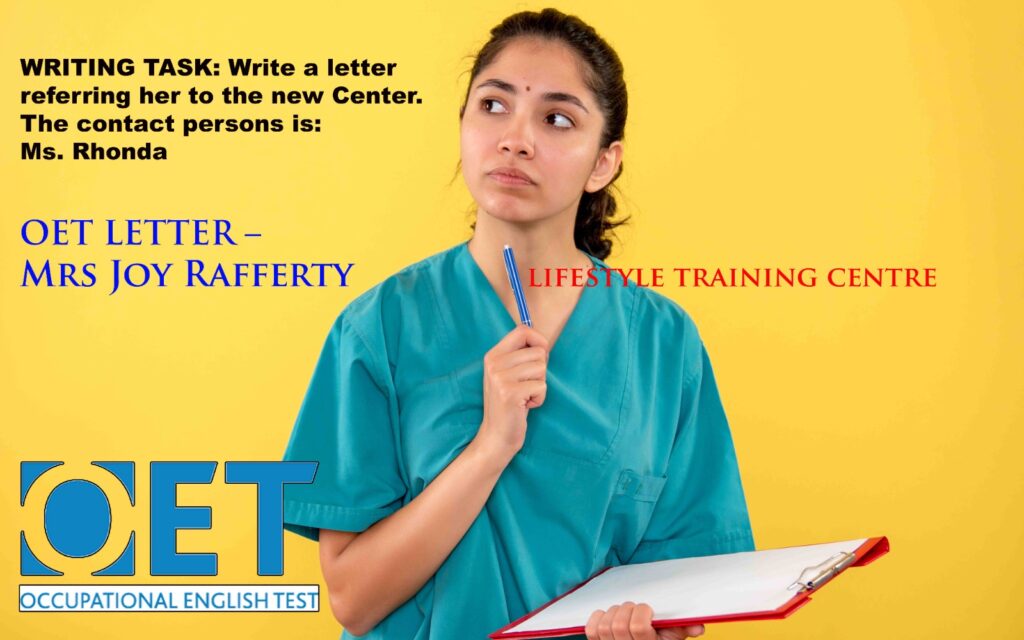
Model answer by Lifestyle Training Centre
Ms. Rhonda Johns,
RN, Community Health Care,
25 River Street,
Clayton, Vic: 31804
12/03/204
Dear Ms Johns,
Re: Mrs Joy Rafferty, aged 65 years.
I am writing to refer Mrs. Rafferty, who requires ongoing management to improve her general health and mitigate social isolation. She has been under our care for the past ten years.
Mrs. Rafferty experiences undifferentiated osteoarthritis-type aches and pains, managed with analgesics. She is on Coversyl, 4mg daily, for her 10-year history of hypertension, which has progressed from benign to essential, reaching 180/100.
Living alone in a housing commission flat since her husband’s passing in 1984, Mrs. Rafferty faces mild depression and limited social engagement. Her overprotective family, including three out of six children, lives nearby, yet she seldom participates in social activities and heavily relies on her family. She reports weight gain in past year 75 kg to 90 kg.
Following Mrs. Rafferty’s discharge today, I kindly request that you assume responsibility for her ongoing care. Please continue engaging with her family to gradually reduce her dependence. Encourage Mrs. Rafferty to actively participate in social activities, including aqua aerobics, local women’s chair, and involvement with the parish visiting group. Additionally, closely monitor her attendance in the above mentioned activities, and motivate her to increase physical exercise to enhance her overall health and fitness. Connect her to Meals on Wheels. Should you have any further inquiries or require additional information, please do not hesitate to contact me.
Yours sincerely,
Registered nurse.
Writing task – Question
ASK 13:
Patient : Mrs. Joy Rafferty
Age: 65.
Occupation : Retired clothing machinist
Patient has attended the Community Health Center since her retirement ten years ago. Recently a new Center has opened much closer to her home.
SOCIAL HISTORY: Widowed since 1984 and has supported the family since her husband’s death
Lives alone in a Housing Commission flat. Has 6 adult children with 3 living nearby in the same suburb
A close family. Social activities are restricted to family occasions. Outside outings are also restricted (Family does her shopping and collects her for outings, etc.). Previously active with the Church and its social circle however this has stopped because the patient can no longer drive.
MEDICAL HISTORY: Benign hypertension over 10 years, now progressing to essential hypertension 180/100 Coversyl 4 mg daily. Rapid weight gain in past year 75 kg to 90 kg
Undifferentiated osteoarthritis type aches and pains, Analgesics required for pain, Mild depression
FAMILY INVOLVEMENT: Several meetings with the family to encourage the patient to make social contacts and therefore become less dependent on the family.
Family concerned and overprotective but in agreement with suggestions
DISCHARGE PLAN: Improve her general health status by Increasing exercise regime and stimulatininer
Continue family meetings. Introduce client to suitable interest and activity groups in the area e.g. Aqua aerobics, local women’s chair, Meals on Wheels, parish visiting groups. Encourage and monitor attendance
WRITING TASK : You are the Community Health Nurse who has been looking after Mrs. Rafferty for the past ten years. You are concerned about her increasing isolation and general health. Write a letter referring her to the new Center. The contact persons is: Ms. Rhonda Johns, RN., Community Health Care, 25 River Street, Clayton, Vic: 31804
OET WRITING TASKSSubmit your OET letters for correction: (for a minimal fee)
https://goltc.in/oet-writing-correction/
We hope this information has been valuable to you. If so, please consider a monetary donation to Lifestyle Training Centre via UPI. Your support is greatly appreciated.

Would you like to undergo training for OET, PTE, IELTS, Duolingo, Phonetics, or Spoken English with us? Kindly contact us now!
📱 Call/WhatsApp/Text: +91 9886926773
📧 Email: [email protected]
Visit us in person by following the directions on Google Maps. We look forward to welcoming you to the Lifestyle Training Centre.
Follow Lifestyle Training Centre on social media:
Thank you very much!